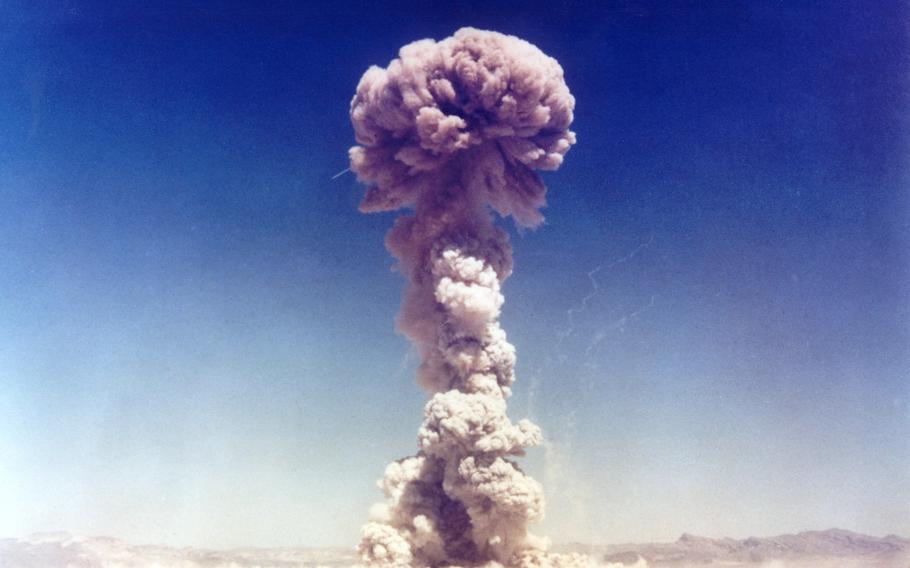
A test detonation of a tactical fission bomb in 1951. Russian scientists have patented a nuclear bomb simulator created to train ground troops on how to operate after a radioactive blast, state-controlled news agency Tass reported this week. (National Archives)
A new nuclear bomb simulator created by Russian scientists, complete with mushroom cloud effects, will enable the Kremlin’s troops to train for combat operations after a radioactive blast, a state-controlled media outlet reported this week.
The report by the Russian news agency Tass comes on the heels of the release of a study for U.S. European Command that seeks to assess Moscow’s revised thinking on the use of nuclear weapons.
The Russian device will show “what a nuclear strike looks like: the shock effect, flash of light and mushroom cloud of a ground-based nuclear explosion,” according to the patent, which was provided to Tass.
The invention will be used in exercises and offer instruction for radiation-detecting units on how to determine the “parameters and epicenter of a nuclear explosion,” according to Tass.
Since the start of Russia’s full-scale invasion of Ukraine in February 2022, concerns about the potential for a nuclear detonation in Europe have escalated.
Russian President Vladimir Putin and others connected to the Kremlin have made various threats during the course of the war.
And in March, former President Dmitry Medvedev, the current deputy secretary of Russia’s Security Council, threatened nuclear retaliation against the West for its support of Ukraine.
“Every day when they provide Ukraine with foreign weapons brings the nuclear apocalypse closer,” Medvedev said, as quoted by The Associated Press.
Some security analysts also argue that the high number of Russian casualties in Ukraine and the loss of large quantities of combat equipment have weakened Russia’s position on its western flank with the Baltic states in NATO.
That could make the Kremlin’s strategy against the alliance more dependent on nuclear weapons, given the state of its conventional forces, according to a report issued Monday that was commissioned by EUCOM.
While NATO and U.S. officials have said the war is likely to end at the negotiating table, it’s unclear what the terms of such an agreement could look like.
But Putin may be open to an agreement that could see Moscow dropping its opposition to Ukrainian membership in NATO, Bloomberg News reported Thursday.
In exchange, Russia would hold on to the Ukrainian territory it is occupying, according to Bloomberg, which cited two unidentified officials with ties to the Kremlin.
However, there are no indications that Ukraine would be up for such a deal or that the U.S. would be interested in pressuring Kyiv to accept such terms.
Ukrainian President Volodymyr Zelenskyy has repeatedly said his country is unwilling to cede any territory to Russia as part of a peace plan.
With the war close to hitting the two-year mark, the fighting has turned into a virtual stalemate after a Ukrainian summer offensive failed to regain significant amounts of territory.
The outlook for Kyiv also is increasingly uncertain, given its reliance on the West for arms and ammunition.
The U.S. is now out of money for Ukraine and can’t send in more weaponry because of budget disagreements in Congress that have put future military support for Kyiv in indefinite limbo.